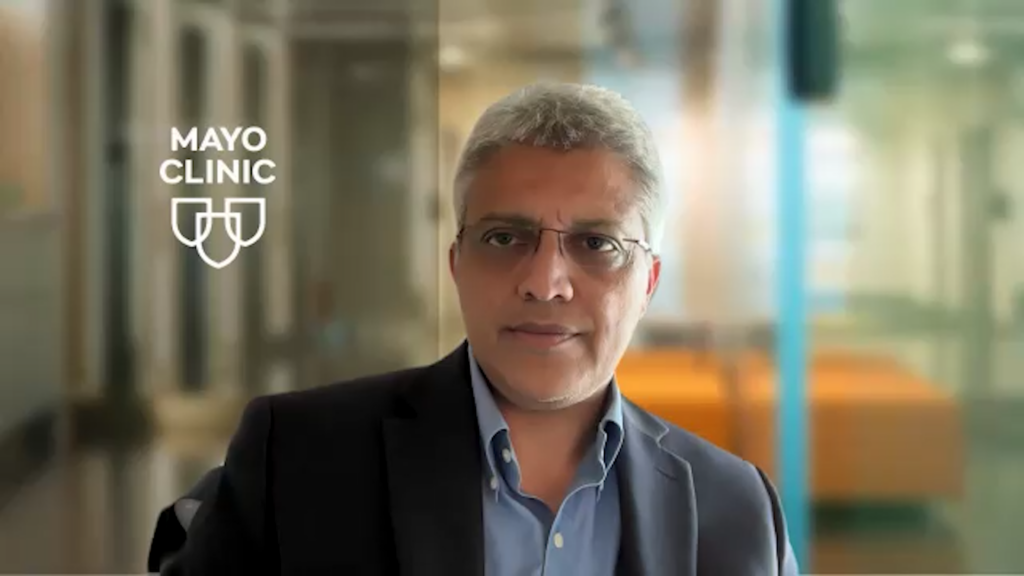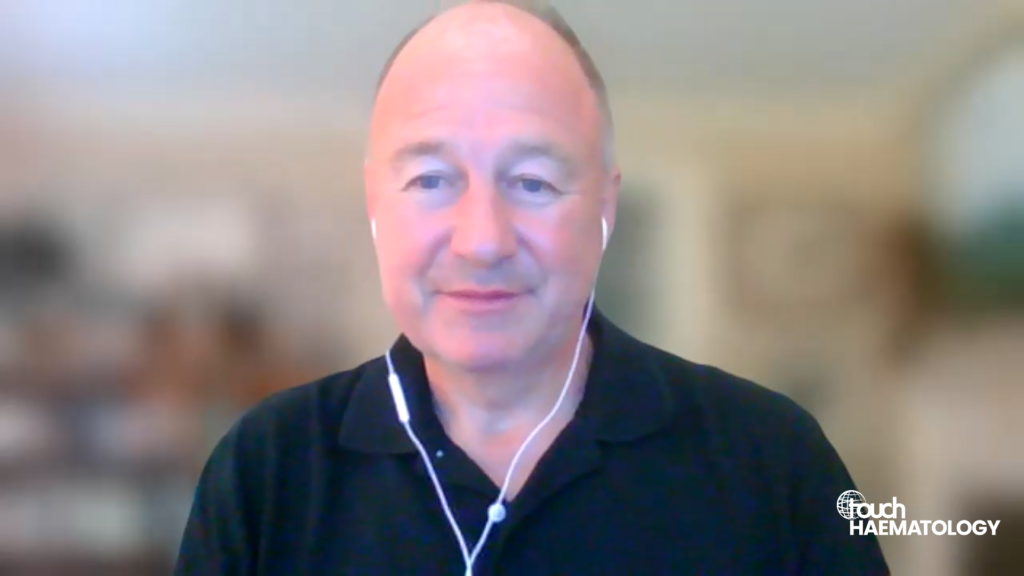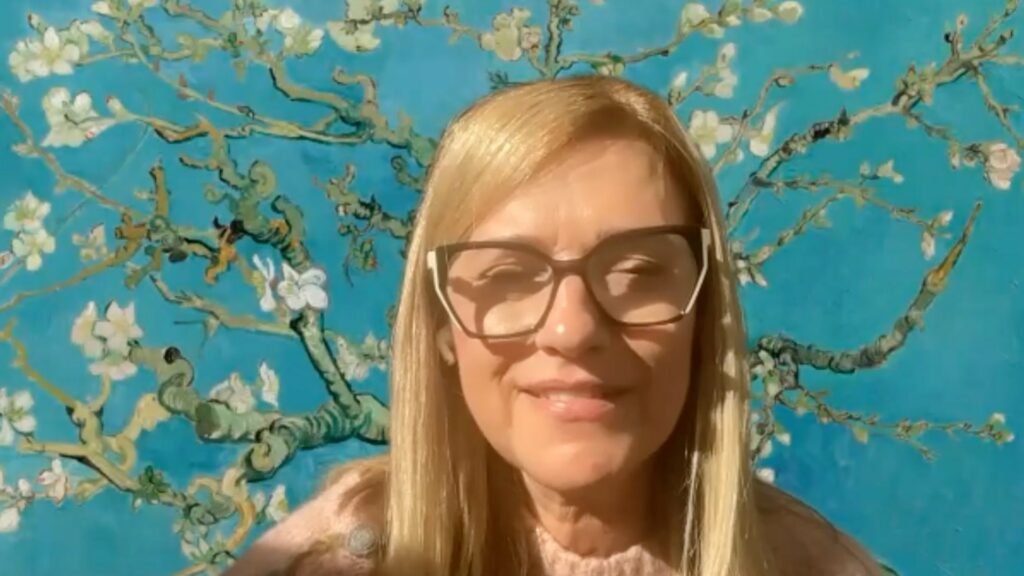touchHAEMATOLOGY coverage of data presented at EHA 2024:
The phase III DREAMM-7 trial evaluated the efficacy and safety of belantamab mafodotin plus bortezomib and dexamethasone (BVd) compared to daratumumab plus bortezomib and dexamethasone (DVd) in relapsed/refractory multiple myeloma (RRMM) patients with ≥1 prior therapy. Involving 494 patients, the study found that BVd significantly improved progression-free survival (PFS) (36.6 months versus 13.4 months) and showed a strong trend towards improved overall survival (OS). BVd also resulted in a higher overall response rate (82.7% versus 71.3%) and longer median duration of response (35.6 months versus 17.8 months). Grade 3/4 adverse events were higher in the BVd group (90% versus 67%), including more frequent but manageable ocular events. These results support BVd as a potential new standard of care for RRMM.
Dr Meletios-Athanasios Dimopoulos (University of Athens School of Medicine, Athens, Greece) discusses the recently published New England Journal of Medicine paper, “Belantamab Mafodotin, Bortezomib, and Dexamethasone for Multiple Myeloma” and associated abstract “Results From DREAMM-7 A Randomized Phase 3 Study Of Belantamab Mafodotin + Bortezomib, And Dexamethasone Vs Daratumumab + Bortezomib, And Dexamethasone In Relapsed/Refractory Multiple Myeloma”, (Abstract S214) presented at the 29th European Hematology Association (EHA) 2024 Congress on 13–16th June 2024 in Madrid, Spain.
Questions
- Could you briefly describe the design and primary endpoints of the DREAMM-7 study in patients with relapsing or remitting multiple myeloma? (0:18)
- What were the main efficacy findings of the DREAMM-7 study? (1:42)
- The study reported a higher incidence of grade 3/4 treatment-related adverse events and serious adverse events in the BVd arm versus DVd. Can you elaborate on the safety profile of BVd compared to DVd? (3:02)
- Based on data from the DREAMM-7 study, how does the BVd regimen compare to the current standard of care, PVd, for patients with RRMM with ≥1 prior line of therapy? (5:38)
- What will be the next steps towards realising the potential of this regime? (7:07)
Disclosures: Dr Meletios-Athanasios Dimopoulos discloses honoraria from participation in advisory boards from Amgen, Takeda, Beigene, Janssen and BMS.
This content has been developed independently by Touch Medical Media for touchHAEMATOLOGY. It is not affiliated with the European Hematology Association (EHA). Unapproved products or unapproved uses of approved products may be discussed by the faculty; these situations may reflect the approval status in one or more jurisdictions. No endorsement of unapproved products or unapproved uses is either made or implied by mention of these products or uses by Touch Medical Media or any sponsor. Views expressed are the speaker’s own and do not necessarily reflect the views of Touch Medical Media.
Abbreviations: BCMA, B-cell maturation antigen; BVd, belantamab mafodotin, bortezomib, and dexamethasone; DVd, daratumumab, bortezomib, and dexamethasone; PFS, progression-free survival.
Transcript:
I am Thanos Dimopoulos. I’m a Professor of Medicine at the National Kapodistrian University of Athens at the Department of Clinical Therapeutics in Alexandra Hospital in Athens, Greece.
Could you briefly describe the design and primary endpoints of the DREAMM-7 study in patients with relapsing or remitting multiple myeloma? (0:18)
DREAMM-7 is a large prospective randomized trial, which included patients who have received at least one, but no more than three, prior lines of therapy. Patients were pretreated with lenalidomide, but they should be naive to anti-CD38 monoclonal antibodies, and also should not be resistant or intolerant to bortezomib. The patients were randomized to either daratumumab with bortezomib and dexamethasone (DVd) as the control arm, or belantamab mafodotin, an antibody–drug conjugate against BCMA, with bortezomib and dexamethasone (BVd). So, essentially, there was a head to head comparison of a daratumumab-containing combination with a belantamab mafodotin combination, in the early-relapse setting of multiple myeloma.
The primary endpoint was progression-free survival, with secondary endpoints being response rate, minimal residual disease negativity and overall survival.
What were the main efficacy findings of the DREAMM-7 study? (1:42)
With a median follow-up of 28.2 months, the median PFS in the belantamab Vd (BVd) arm was 36.6 months versus 13.4 months with daratumumab Vd (DVd), and the hazard ratio of 0.41. The overall survival data were not mature. However, median survival was not reached in either arm, but the hazard ratio was 0.57, indicating that there is a clear survival advantage in favour of, the BVd arm. The overall response rate was 82.7% BVd versus 71.3% for DVd. However, the complete response rate was much higher in favour of BVd. So all the endpoints were met in favour of the investigational arm.
The study reported a higher incidence of grade 3/4 treatment-related adverse events and serious adverse events in the BVd arm versus DVd. Can you elaborate on the safety profile of BVd compared to DVd? (3:02)
The main differences between the two arms was the ocular toxcity, which was a known complication of belantamab mafodotin. It is due to a microcystic keratopathy. However, clinically relevant ocular toxicity, meaning blurred vision, decreased visual acuity to 20/50, was observed in approximately one-third of the patients treated with the belantamab combination. And in these particular patients, the way to address this complication that could interfere with daily activity of the patients – patients had difficulties reading, watching TV, using their cell phone or driving – was to hold the belantamab mafodotin until there was a clinical recovery of the ocular toxicity, and then to restart at lower doses. With this approach, in almost all patients, this ocular toxicity resolved. Furthermore, there was no evidence that the belantamab-containing combination lost its activity with this delay of treatment. For example, for patients who had at least one dose given 12 or more weeks apart, the median PFS was similar for the overall median PFS of the study.
Another complication which appeared more often in patients treated with belantamab, bortezomib and dexamethasone was the increased rate of neutropenia and a slightly higher rate of infections. But we know that whenever we administer these monoclonal antibodies it is expected to have a slightly higher rate of infections.
Also, we have to keep in mind that this study was conducted during the COVID era. So there were several patients that had a COVID infection.
Based on data from the DREAMM-7 study, how does the BVd regimen compare to the current standard of care, PVd, for patients with RRMM with ≥1 prior line of therapy? (5:38)
I believe that for patients who are progressing on lenalidomide, but have not been exposed to an anti-CD38 monoclonal antibody, the results that we have obtained with belantamab bortezomib and dexamethasone are the best so far. And it is of interest, also, to note that, there was an equal benefit in patients with standard-risk and high-risk cytogenetics, which is something we do not usually see with novel combinations. So, definitely, there is a significant advantage by using this combination, and we hope and expect that when this combination is approved by regulatory authorities it will be widely used by practising clinicians, especially now that, with increased experience with the use of belantamab mafodotin, we know how to better evaluate ocular toxicities and mitigate and address those by holding the dose and giving it at longer intervals and at lower doses.
What will be the next steps towards realising the potential of this regime? (7:07)
This study is being continued because we want to have mature data regarding overall survival. As I said, there is always evidence that the overall survival is in favour of belantamab with bortezomide and dexamethasone. However, we need more follow-up, to have the median overall survival reached, and also to observe for potential long-term side effects and complications of this regimen.
Interviewer/Editor: Helen Bowden
Cite: Dimopoulos M-A. Very early FDG-PET-response adapted targeted therapy for advanced Hodgkin lymphoma. touchHAEMATOLOGY. July 29 2024.





